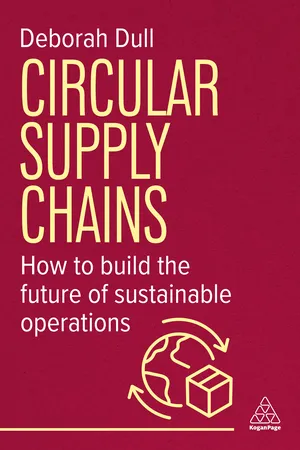
- English
- ePUB (mobile friendly)
- Available on iOS & Android
About this book
How can your supply chain drive sustainability and competitive advantage?
Circular Supply Chains by Deborah Dull is a practical guide for supply chain managers, analysts and strategists looking to shift from linear processes to circular, regenerative operations. As climate pressures rise, materials grow scarce and stakeholder expectations increase, this book shows how to embed circularity into every stage of your supply chain.
Written for professionals ready to turn ambition into action, it bridges theory and execution through strategic models, digital tools and real-world examples that support transformation at scale.
You'll learn how to:
- Map, plan and optimize supply networks for circular outcomes
- Apply digital tools like repair demand sensing and radical transparency
- Integrate regenerative principles into sourcing, planning and logistics
- Use checklists and frameworks to drive measurable change
With a clear path from today's systems to future-ready supply chains, this is the essential resource to help mid-career professionals lead with resilience, innovation and impact.
Start building circular operations that deliver on sustainability, efficiency and long-term value.
Themes include: circular economy, regenerative supply chain, sustainable sourcing, logistics innovation, digital supply tools, supply network planning
Frequently asked questions
- Essential is ideal for learners and professionals who enjoy exploring a wide range of subjects. Access the Essential Library with 800,000+ trusted titles and best-sellers across business, personal growth, and the humanities. Includes unlimited reading time and Standard Read Aloud voice.
- Complete: Perfect for advanced learners and researchers needing full, unrestricted access. Unlock 1.4M+ books across hundreds of subjects, including academic and specialized titles. The Complete Plan also includes advanced features like Premium Read Aloud and Research Assistant.
Please note we cannot support devices running on iOS 13 and Android 7 or earlier. Learn more about using the app.
Information
Table of contents
- About the author
- Part ONE Forming Circular Supply Chains from Key Concepts
- Introduction
- 01 Events Leading to Today’s Economy
- 02 The Pioneers of Circular Thinking
- 03 Where Circular Economy Meets Supply Chain
- 04 Building Tomorrow’s Circular Supply Chain
- Part Two The Capability to Repair at Scale
- 05 People and Culture Capabilities: Repairing at Scale
- 06 Process Capabilities: Orchestrating Circular Flows to Repair at Scale
- 07 Technology Capabilities: Digital Enablement to Repair at Scale
- 08 Industry Standards Capabilities: Common Language for Circularity to Repair at Scale
- 09 Governance Capabilities: Ensuring Circular Success to Repair at Scale
- Part Three The Capability to Manufacture In-Market
- 10 People and Culture Capabilities: Manufacturing In-Market
- 11 Process Capabilities: Orchestrating Circular Flows to Manufacture In-Market
- 12 Technology Capabilities: Digital Enablement to Manufacture In-Market
- 13 Standards Capabilities: Common Language for Circularity to Manufacture In-Market
- 14 Governance Capabilities: Ensuring Circular Success to Manufacture In-Market
- Part Four The Capability to Circulate Locally
- 15 People and Culture Capabilities: Circulating Locally
- 16 Process Capabilities: Orchestrating Circular Flows to Circulate Locally
- 17 Technology Capabilities: Digital Enablement to Circulate Locally
- 18 Standards Capabilities: Common Language for Circularity to Circulate Locally
- 19 Governance Capabilities: Ensuring Circular Success to Circulate Locally
- Part Five The Capability to Collaborate Transparently
- 20 People and Culture Capabilities: Collaborating Transparently
- 21 Process Capabilities: Orchestrating Circular Flows to Collaborate Transparently
- 22 Technology Capabilities: Digital Enablement to Collaborate Transparently
- 23 Standards Capabilities: Common Language for Circularity to Collaborate Transparently
- 24 Governance Capabilities: Ensuring Circular Success to Collaborate Transparently
- Part Six Conclusion
- 25 Next Steps
- Index